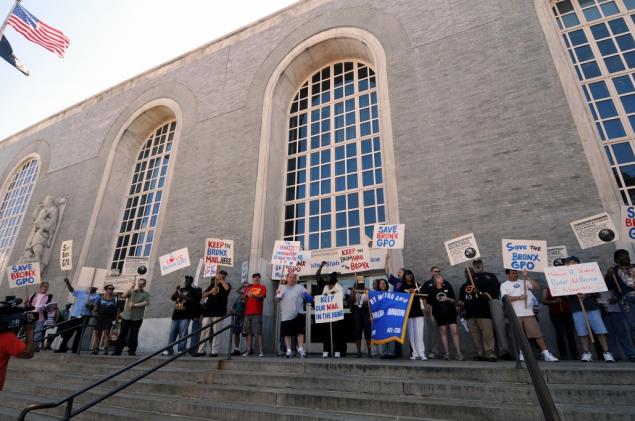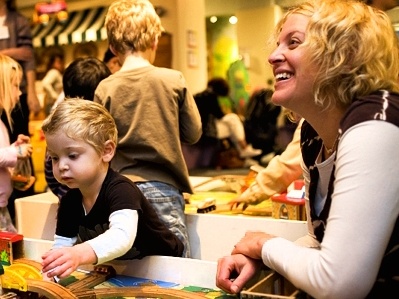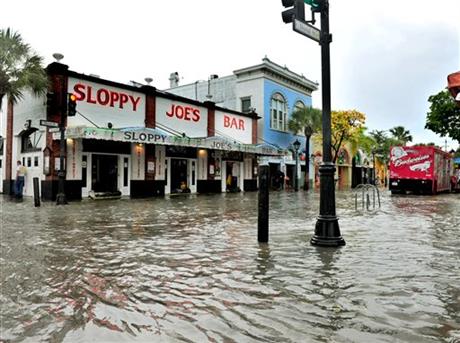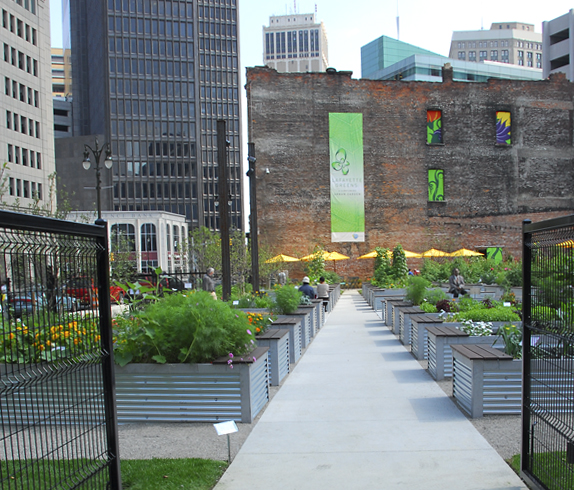 An article published in the Washington Post earlier this week highlights the dramatic decline of the United States Postal Service and the financial difficulty that it is facing today. Since the passing of the Postal Accountability and Enhancement Act (PAEA) in 2006, the postal service has started running massive deficits has been forced to lay off tens of thousands of workers. To remedy this financial mess, the USPS has increasingly started to sell historic Post Office buildings, often centrally located on valuable tracts of land, to raise money. An article published in the Washington Post earlier this week highlights the dramatic decline of the United States Postal Service and the financial difficulty that it is facing today. Since the passing of the Postal Accountability and Enhancement Act (PAEA) in 2006, the postal service has started running massive deficits has been forced to lay off tens of thousands of workers. To remedy this financial mess, the USPS has increasingly started to sell historic Post Office buildings, often centrally located on valuable tracts of land, to raise money.
Read more »
On Thursday, the National League of Cities released The 10 Critical Imperatives Facing Cities in 2014, its annual report highlighting ten of the most pressing issues facing cities across the United States. Partners board member and incoming NLC President, Salt Lake City Mayor Ralph Becker explained during the report's unveiling, "This is not a wish list just of cities. This is a wish list of the people who live in America. That’s 80 percent of the population of America that’s being represented through us."
The ten items on the list were:
- Fragile Fiscal Health
- Deteriorating Transportation Infrastructure
- The Shrinking Middle Class
- Inadequate Access to Higher Education
- The Need for Affordable Housing
- A Less-Than-Welcoming Return for Veterans
- Gang Violence
- A Broken Immigration System
- Climate Change and Extreme Weather
- Lack of Public Trust
Click here to read the full report from NLC, which includes an overview of initiatives being taken by cities in their own efforts to tackle these ten challenges and create more livable communities for their residents.
Read more »
Terms:Community Building, Community Development, Downtown Development, Economic Development, Education, Environment, Health & Wellness, Housing, Immigration, Neighborhood Revitalization, Other Reports/Publications, Placemaking, Public-Private Partnerships, Transportation, Urban

The Habitot Children’s Museum first opened its doors in downtown Berkley in 1998, and the institution has served over 950,000 residents of underserved communities in the Bay Area since. The 7,000 sq. foot facility is home to exhibits that help teach kids about the value of physical activity, water preservation, and art and culture. The hands-on Museum encourages early childhood education and aims to help support a generation of curious and creative kids.
Read more »
Terms:Arts & Culture, Community Building, Creative Economy, Cultural Institutions, Downtown Development, Education, Families, IFC Best Practice, Institutions as Fulcrums of Change , Museums, Youth

As climate change remains contentious topic in American politics on the federal level, more and more cities are taking it upon themselves to find solutions that will address this growing problem. Key West, Florida, is a popular tourist destination and also one of the most vulnerable places in the United States to rising sea levels. Like many places in South Florida, Key West is very flat, with many neighborhoods, including the downtown hub of tourist activity, reaching no higher than 3 ft. above sea level.
Read more »

In 1923, when the Lafayette Building was constructed in downtown Detroit, the city was one of the cultural centers of the United States and home to an exploding automotive industry. Famous American architect C. Howard Crane designed the cutting edge, Italian Renaissance-style building in a unique ‘V’ shape to maximize the amount of natural light allowed in. Today, however, Detroit has fallen on harder economic times, and the once striking skyscraper at 144 West Lafayette was torn down in 2010 after being vacant for more than a decade.
Read more »
Terms:Community Building, Cultural Institutions, Downtown Development, Environment, Health & Wellness, Historic Preservation, IFC Best Practice, Neighborhood Revitalization, Parks, Playgrounds & Gardens, Urban
 Here is a section of sidewalk in Boston made from brick pavers. It’s clear that the lack of uniform sizes and heights could pose challenges for the disabled or elderly pedestrian. Photo credit Seldom Scene Photography. Here is a section of sidewalk in Boston made from brick pavers. It’s clear that the lack of uniform sizes and heights could pose challenges for the disabled or elderly pedestrian. Photo credit Seldom Scene Photography.
Designers, planners, and members of the public have recently come into conflict over Boston’s historic use of molded brick in sidewalks and public spaces. Some think the use of bricks represents the face of Boston, while others condemn them as obstacles to the disabled and elderly. The different viewpoints amount to an ownership debate on the city’s public space.
The City’s Commission for Persons with Disabilities maintains that traditional, molded bricks are unable to provide the smooth surfaces (meaning no height variations greater than a quarter of an inch) that the Americans with Disabilities Act requires. However, other professionals (landscape architects, historical preservationists, and the brick industry) affirm that the material itself is not to blame, but rather improper installation and maintenance.
Read more »
Terms:2012, Aging, Arlington County, VA, Boston, MA, City Leaders Institute on Aging in Place, Design, Downtown Development, Fairfax, VA, Historic Preservation, Mobility, Washington, DC
Entrepreneurial American Leadership Award
Richard C.D. Fleming is honored for his commitment to building livable and sustainable cities as a civic entrepreneur for more than 30 years while engaged in private sector and civic initiatives to revitalize cities and metropolitan communities in Atlanta, Denver, and, for the past 17 years, St. Louis.
Read more »
Terms:2011, Awards, Board, Chamber of Commerce, Community Development, Community Engagement, Downtown Development, Economic Development, St. Louis, MO, Visioning & Planning
"So, what is the point of public art? ” This question, posted online by Voice of San Diego's Kelly Bennett, came in response to the city of San Diego’s recent pull from public art funding; after its release on Twitter the post quickly turned viral. Responses to the post ranged from views of public art as superfluous and its place in the public sphere as luxury, to public art as necessary for community well-being, safety, and cohesiveness.
Many of us believe in the arts as integral to the livable community— but when measuring out our federal dollars, the arts are usually the first to go. But what if we could prove that in addition to instilling neighborhood pride and value in our public space, public art could actually serve as a deterrent for crime and violence?
Read more »
Terms:2010, Arts & Culture, Community Building, Community Development, Community Engagement, Creative Economy, Downtown Development, Economic Development, Multicultural, Neighborhood Revitalization, Placemaking, Public Art, San Diego, CA, Urban
Entrepreneurial Livable Community Award
For the community’s entrepreneurial spirit in its transformation to become a model for sustainable development and prosperity today.
Read more »
William H. Whyte Award
For his contributions to creating more environmentally, socially, and financially sustainable communities through his work as a developer, academic, and author.
Read more »
How does a city aspire to be livable when the outside public seemingly brands it as ‘dying?’ How does the city grow when it is told that is 'shrinking’? With eyes that are turning away from the core industrial cities and onto the technological hubs of the twenty-first century: can the city sustain itself? For Mayor Jay Williams of Youngstown, OH, hearing his city being labeled by Forbes Magazine as one of Americas 10 Fastest-Dying Cities, inspired him to take the city in a new direction; one that leveraged successful development upon its own definition.
At the “ Building Livable Communities” forum held at Washington, DC's Hirshhorn Museum and Sculpture Garden on September 22, 2010, Mayor Williams held a detailed discussion on how civic institutions in Youngstown redefined their role to promote dynamic change as amenity rich centers.
Mixed-Use downtown developments outperform “big box” developments in tax revenue-per-acre, reports Mary Newsom for Citiwire.net. Newsom explains the results of a recent study in Sarasota County Florida, and what it means for the way we grow our communities. Click here for the full story.
Read more »
On a recent visit to Denver, Linda Severson was surprised to find herself ignoring the city’s famed scenery to examine one of Denver’s lesser known wonders: its parking meters.
Denver is one of a number of U.S. cities that has installed brightly colored, repurposed parking meters designed to take donations to services for the city’s homeless. Intrigued by these “donation stations,” Severson took the idea back to her role as human services coordinator for the Johnson County Council of Governments, in Eastern Iowa.
Her timing was apt. Iowa City, the county seat, was then in the process of revising their panhandling ordinance, which would increase the restrictions on where panhandling could take place in the downtown area. It seemed like the perfect time to offer what city officials have now deemed an “alternative” to panhandling.
Read more »
An organization that works with the existing cultural and historical strengths of Rocky Mount to revitalize the community’s economic health.
Read more »
Terms:Arts & Culture, Community Development, Downtown Development, Economic Development, Heritage, Historic Preservation, Housing, Jobs, Neighborhood Revitalization, Rocky Mount, NC
Minneapolis, MN
A central gathering place, market, and community center for members of the Minneapolis Latino community.
Read more »
Partners' President Bob McNulty stops in on Ipswich, Australia—a city Partners has been working with for almost 10 years—to check out all the new activity and growth the city has experienced in the last 2 years. Read more about his vist to Ipswich>
Click here to read more about Ipswich, Australia—An Entrepreneurial City>
Read more »
Washington, D.C.
A committee made up of arts, business, and civic leaders dedicated to the cultural development of the Washington, D.C. community.
Read more »
Terms:Arts & Culture, CBC Best Practice, Community Development, Creative Economy, Cultural Institutions, Culture Builds Communities, Downtown Development, Economic Development, Neighborhood Revitalization, Urban, Washington, DC
Jackson, MS
A former shopping mall that has been converted into a comprehensive, multidisciplinary health care complex.
Read more »
Terms:Aging, Downtown Development, Economic Development, Health & Wellness, Intergenerational, Jackson, MS, Public-Private Partnerships, Social Services, Town-Gown, Urban
North Adams, MA
A cultural institution has brought stupendous growth to the surrounding community.
Read more »
Terms:Arts & Culture, CBC Best Practice, Community Development, Cultural Institutions, Culture Builds Communities, Design, Downtown Development, Economic Development, Historic Preservation, Museums, Neighborhood Revitalization, North Adams, MA, Tourism, Town-Gown
St. Paul, MN
A development bank and vehicle to fund the revitalization of the Lowertown area in downtown St. Paul.
Read more »
Terms:Community Development, Community Engagement, Design, Downtown Development, Economic Development, Housing, Neighborhood Revitalization, Public-Private Partnerships, St. Paul, MN, Visioning & Planning
|
|